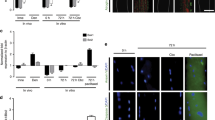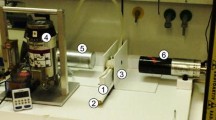Summary
-
1.
Asymmetric forms of AChE have generally not been detected in cultured chick skeletal muscle cells in the absence of cocultured neurons. To explore further neurotrophic effects of adult peripheral nerve extracts (NE) on musclein vitro, we reexamined the appearance of various molecular forms of AChE in cultured chick muscle cells in the presence of NE.
-
2.
The various molecular forms of AChE were distinguished by sucrose gradient sedimentation and radioenzymatic techniques.
-
3.
In the presence of NE, cells proliferated during the first 48 hr of culture, then fused and formed spontaneously contracting myotubes by 6–8 days in culture.
-
4.
Total AChE, 5.4 S, and 11.5 S molecular forms reached activity plateaus by 8 days in culture which persisted until cultures were terminated at day 20.
-
5.
Betweeen 1 and 6 days in culture, 19.5 S AChE (A12) was not detected. The A12 form was first observed at 7 days reaching a maximum of 11.3% of the total AChE at 14 days and then gradually declined to a level of 1% at day 20.
-
6.
Since the A12 form declined in older cultures but comprised 25% in embryonic muscle tissue, we examined the possible requirement of neurons in culture to attain higher levels of A12 AChE. Spinal cord neurons were plated onto 6-day muscle cultures and AChE activities were measured between 8 and 20 days.
-
7.
The results showed that 19.5 S AChE activity in the presence of both spinal cord neurons and NE was no greater than that found in the presence of NE alone.
-
8.
To suppress spontaneous contraction, 0.6µM tetrodotoxin (TTX) or 15µM d-tubocurarine (dTC) were added to 5-day-old muscle cultures at a time when myotubes were differentiated but contractile activity had not begun.
-
9.
TTX had cytotoxic effects and inhibited further development of myotubes. In contrast, dTC had no deleterious effect on morphological development, eliminated contraction, but did not interfere with the appearance of any forms of AChE including the A12 form.
-
10.
These studies show that primary chick muscle cells are capable of producing the A12 form of AChE if cultured in NE-supplemented medium. In this culture system, production of the A12 form does not require activity or innervation.
Similar content being viewed by others
References
Allemand, P., Bon, S., Massoulie, J., and Vigny, M. (1981). The quarternary structure of chicken acetylcholinesterase and butyrylcholinesterase; Effect of collagenase and trypsin.J. Neurochem. 36860–867.
Barnes, D., and Sato, G. (1980). Methods for growth of cultured cells in serum-free medium.Anal. Biochem. 102255–270.
Beach, R. L., Popiela, H., and Festoff, B. W. (1983). The identification of neurotrophic factor as a transferrin.FEBS Lett. 156151–156.
Buckley, P. A., and Konigsberg, I. R. (1974). Myogenic fusion and the duration of the post-mitotic gap (G1).Dev. Biol. 37193–212.
Bulger, J. E., Patterson, G. T., and Wilson, B. W. (1981). Properties and regulation of AChE from cultured chicken and quail muscle.J. Cell Biol. 91:350a.
Cisson, C. M., McQuarrie, C. H., Sketelj, J., McNamee, M. G., and Wilson, B. W. (1981). Molecular forms of acetylcholinesterase in chick embryonic fast muscle: Developmental changes and effects of DFP treatment.Dev. Neurosci. 4157–164.
Cohen, S. A., and Fischbach, G. D. (1973). Regulation of acetylcholine sensitivity by muscle activity in cell culture.Science 18176–78.
de la Porte, S., Massoulie, J., Vigny, M., and Koenig, J. (1982). Collagen-tailed A12 form of acetylcholinesterase in veratridine-paralyzed cultures of rat muscle cells. 5th Int. Congr. Neuromusc. Dis., Marseille, France.
Fernandez, H. L., Duell, M. J., and Festoff, B. W. (1979). Cellular distribution of 16S acetylcholinesterase.J. Neurochem. 32581–585.
Hall, Z. W. (1973). Multiple forms of acetylcholinesterase and their distribution in endplate and non-endplate regions of rat diaphragm muscle.J. Neurobiol. 4343–361.
Ham, R. G. (1965). Clonal growth of mammalian cells in a chemically defined, synthetic medium.Proc. Natl. Acad. Sci. 53288–293.
Hauschka, S. D. (1972). Cultivation of muscle tissue. InGrowth, Nutrition and Metabolism of Cells in Culture (Rothblat, G. H., and Cristofalo, V. J., (Eds.), Academic Press, New York, pp. 67–122.
Johnson, C. D., and Russel, R. L. (1975). A rapid, simple radiometric assay for cholinesterase suitable for multiple determinations.Anal. Biochem. 64229–238.
Kato, A. C., Vrachliotis, A., Fulpius, B., and Dumant, Y. (1980). Molecular forms of acetylcholinesterase in chick muscle and ciliary ganglion: Embryonic tissues and cultured cells.Dev. Biol. 76222–228.
Koenig, J., and Vigny, M. (1978). Formes moleculaires d'acetylcholinesterase dans le muscle lent et le muscle rapide du poulet.C.R. Soc. Biol. (Paris) 1721069–1074.
Konigsberg, I. R. (1979). Skeletal myoblasts in culture. InMethods in Enzymology. Cell Culture (Jakoby, W. B., and Pastan, I. H., (Eds.), Academic Press, New York, pp. 511–527.
Massoulie, J., and Bon, S. (1982). The molecular forms of cholinesterase and acetylcholinesterase in vertebrates.Ann. Rev. Neurosci. 557–106.
Mc Keehan, W. L., Hamilton, W. G., and Ham. R. G. (1976). Selenium is an essential trace nutrient for growth of WI-38 diploid human fibroblasts.Proc. Natl. Acad. Sci. 732023–2027.
Mc Keehan, W. L., McKeehan, K. A., Hammond, S. L., and Ham. R. G. (1977). Improved medium for clonal growth of human diploid fibroblasts at low concentrations of serum protein.In Vitro 13399–416.
Popiela, H. (1978). Trophic effects of adult peripheral nerve extract on muscle cell growth and differentiation in vitro.Exp. Neurol. 62405–416.
Popiela, H., and Ellis, S. (1981). Neurotrophic factor: Characterization and partial purification.Dev. Biol. 83266–277.
Popiela, H., Ellis, S., and Festoff, B. W. (1982a). Dose-dependent initiation of myogenesis by neurotrophic factor.J. Neurosci. Res. 8547–567.
Popiela, H., Flowers, C., and Festoff, B. W. (1982b). Peripheral nerve extract: Developmental appearance of asymmetric acetylcholinesterase (AChE) in cultured chick muscle cells in the absence of innervation.Soc. Neurosci. Abstr. 8195.
Puck, T. T., Cieciura, S. J., and Robinson, A. J. (1958). Genetics of somatic mammalian cells. III. Long-term cultivation of euploid cells from human and animal subjects.J. Exp. Med. 108945–956.
Reiser, G., Gunther, A., and Hamprecht, B. (1983). Blockade by neurotransmitter antagonists of veratridine-activated ion channels in neuronal cell lines.J. Neurochem. 40493–502.
Rieger, F., Koenig, J., and Vigny, M. (1980). Spontaneous contractile activity and the presence of the 16S form of acetylcholinesterase in rat muscle cells in culture: Reversible suppressive action of Tetrodotoxin.Dev. Biol. 76358–365.
Rotundo, R. L., and Fambrough, D. M. (1979). Molecular forms of chicken embryo acetylcholinesterase in vitro and in vivo.J. Cell Biol. 2544790–4799.
Rubin, L. L., Schuetze, S. M., Weil, C. L., and Fischbach, G. D. (1980). Regulation of acetylcholinesterase appearance at neuromuscular junctions in vitro.Nature 283264–267.
Senni, M. I., Biagioni, S., Marini, P., and Scarsella, G. (1981). Acetylcholinesterase activity and molecular forms during denervation and reinnervation in extensor digitorum longus muscle of the rat.Neurochem. Res. 61291–1298.
Silman, I., DiGiamberardino, L., Lyles, J., Couraud, J. Y., and Barnard, E. A. (1979). Parallel regulation of acetylcholinesterase and pseudocholinesterase in normal, denervated and dystrophic chicken skeletal muscle.Nature 280160–162.
Sketelj, J., McNamee, M. G., and Wilson, B. W. (1978). Effect of denervation on the molecular forms of acetylcholinesterase in normal and dystrophic chicken muscles.Exp. Neurol. 60624–629.
Vigny, M., Koenig, J., and Rieger, F. (1976). The motor end-plate specific form of acetylcholinesterase: Appearance during embryogenesis and re-innervation of rat muscle.J. Neurochem. 271347–1353.
Younkin, S., Brockman, S., Newman, J., and Younkin, L. (1982). Effect of fibrillation on AChE in cultured rat myotubes.Soc. Neurosci. Abstr. 8670.
Author information
Authors and Affiliations
Rights and permissions
About this article
Cite this article
Popiela, H., Beach, R.L. & Festoff, B.W. Appearance of acetylcholinesterase molecular forms in noninnervated cultured primary chick muscle cells. Cell Mol Neurobiol 3, 263–277 (1983). https://doi.org/10.1007/BF00710952
Received:
Revised:
Accepted:
Issue Date:
DOI: https://doi.org/10.1007/BF00710952




